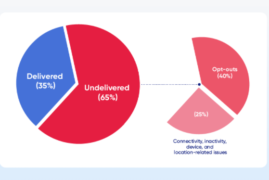The mobile world is an extremely cruel environment, where apps rise to fame and fall into the abyss faster than you can say Angry Birds. In such a digital jungle, being able to know your way around and draw the maximum out of your apps and mobile games in terms of number of active users, user retention, in-app purchases, marketing campaigns and strategies is crucial to success.
Mobile marketing is an infallible part of the equation – you need to let people know your app or mobile game is out there, otherwise it will drown in the sea of apps that keeps on getting bigger.
A few important questions a person trying to advertise a product are:
- Who to advertise to?
- Where to advertise?
- When to advertise?
In this article we will take a closer look at these three questions, getting into more details over when people are most active with their mobile devices, what they’re doing at the time and how you can take advantage of it in the effort to advertise your product.
LOOKING AT THE NUMBERS
If you take a look around, you’ll see a bunch of family and friends constantly staring at the tiny screen in their hands. If you go online, on Facebook or Twitter, you’ll see a lot of people complaining how everyone else is turning into a zombie, completely hypnotized by the sinister little piece of shiny plastic.
You’d think that it doesn’t really matter when you’ll kickstart a mobile marketing campaign – people are looking at their phones constantly, right?
Wrong.
In reality, there is a huge difference in the time of day (and week) people use their mobile devices. According to a recently released SOOMLA Q1 2016 Mobile Insights Report, weekends are the time of week when people are most active.
“In general, users are more active on weekends, with Saturday being the strongest day,” the report suggests, saying that the DAU (Daily Active Users) is at its lowest point on Monday, and its highest point on Saturday.
Other sources confirm this statistic, too. An Appsflyer report into the State of App Marketing suggests that install activity during the weekend jump 25% for the iOS, and 6% for Android-powered devices.
But just being ‘active’ doesn’t do much, does it? You need the time of day, week or even year when the users are in a shopping mood, turning that usage into spending. Luckily for us, that’s also during the weekend, making that time of the week ideal for a marketing campaign.
“Weekends see 3050% more DAU,” the report stresses.
“In other words weekends are a great time for launching a game or carrying out promotions.”
In terms of who you should be targeting, there’s a specific group of people that can be reached out to – people who have already purchased something in a previous game. The SOOMLA report states that players who have made ingame purchases are six times more likely to make a purchase in the next game, and as the number of games played increases, so does the spending grow.
This is also an important factor when planning your advertising strategy.
CHOOSING THE RIGHT DEVICE
I may have already convinced you to try and prepare a marketing campaign for your mobile app or game that will focus on the last three days of the week, but there are other important factors to consider – the type of device you should focus on, for example.
No, I won’t tell you to focus on smartphones or tablets (or both), but there are a couple of important metrics that can help you make your choice, taking into consideration your target audience and the type of product you’re advertising.
People act differently when using smartphones and tablets which is a no-brainer, really. Smartphones are usually used on the go, while tablets are the preferred laid-back device.
This chart from the SOOMLA report suggests that while users play more sessions on their phones, the sessions are longer when playing on tablets.
By leveraging all the information acquired, you can target the group which is known to be a spender, and do it during the time of week that’s known to be a good time for mobile shopping.
All things considered, we can safely conclude that the weekend is a great time to plan your marketing strategy around. People generally use their devices more during the days off, and are more inclined to making new purchases just then.

app keyword installs

